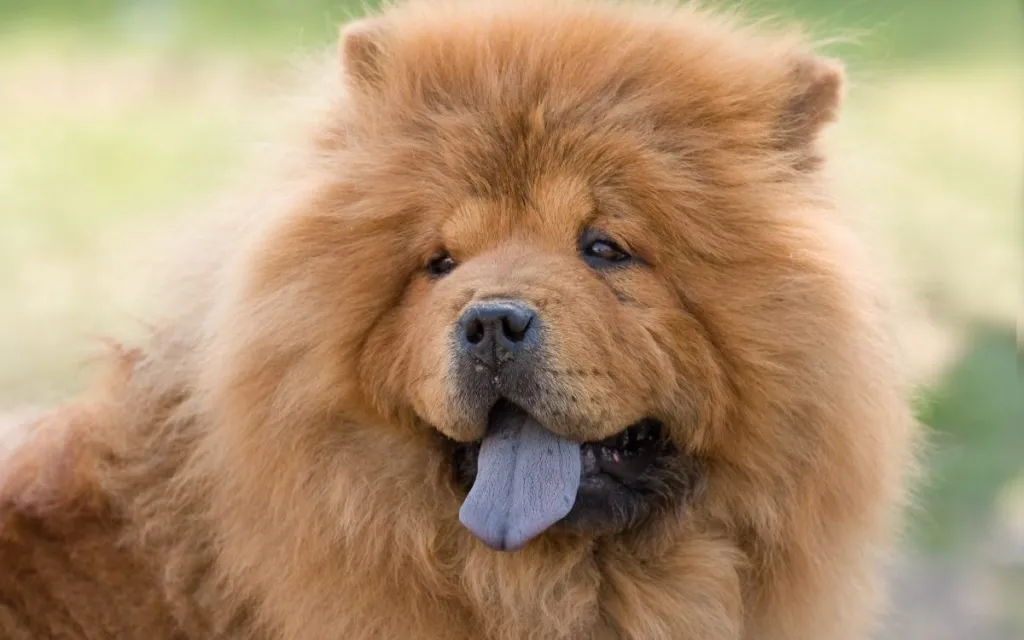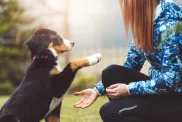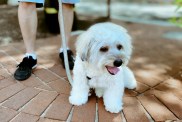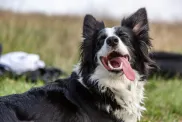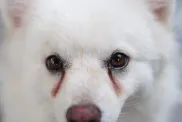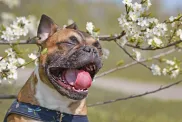The Chow Chow is an ancient breed known for its lion-like appearance and distinctive blue-black tongue. This medium-to-large-sized dog originated in China and has a rich history that dates back thousands of years. They originally served various purposes, including hunting, guarding, and pulling carts. Today, people primarily know them as loyal companions and family pets.
These regal dogs have a unique appearance characterized by their sturdy build, a lion-like mane, and a thick double coat that comes in various colors, including red, black, blue, cinnamon, and cream. Their deep-set, almond-shaped eyes exude a sense of dignity and intelligence. They have a distinctive scowl-like expression, which adds to their regal appearance.
Generally reserved, they may be cautious around strangers. Early socialization and training are crucial. While they may seem distant to some, They are fiercely loyal and protective of their families. Additionally, their protective nature makes them excellent watchdogs, as they will alert their owners to any perceived threats. While not overly demonstrative in showing affection, they form strong bonds with their families. They may not be as exuberant as other breeds, but their dignified demeanor and devotion make them endearing companions.
This active breed requires regular exercise to stimulate them physically and mentally. Daily walks and playtime in a securely fenced yard are essential to keep them happy and healthy. They also benefit from early training and socialization to help them become well-behaved and adaptable.
Quick Facts
- Origin: China
- Size: Medium-sized, 18-22 inches tall at the shoulder
- Breed group: Working dog
- Lifespan: 10-15 years
- Coat: Thick, double coat that comes in red, black, blue, cinnamon, and cream
- Temperament: Independent, loyal, aloof, dignified
- Exercise needs: Moderate
- Training: Can be stubborn, but can be trained with patience and consistency
- Grooming: Regular brushing required
- Health problems: Hip dysplasia, elbow dysplasia, eye problems
- The Chow Chow’s blue-black tongue is unique to this breed.
- Martha Stewart has several Chow Chow dogs, which are often featured on her shows.
- Sigmund Freud, the father of psychoanalysis, was one of the most famous Chow Chow owners in history. Freud’s Chows often helped him in his work as a therapist, providing comfort and support to his patients.
Chow Chow Pictures
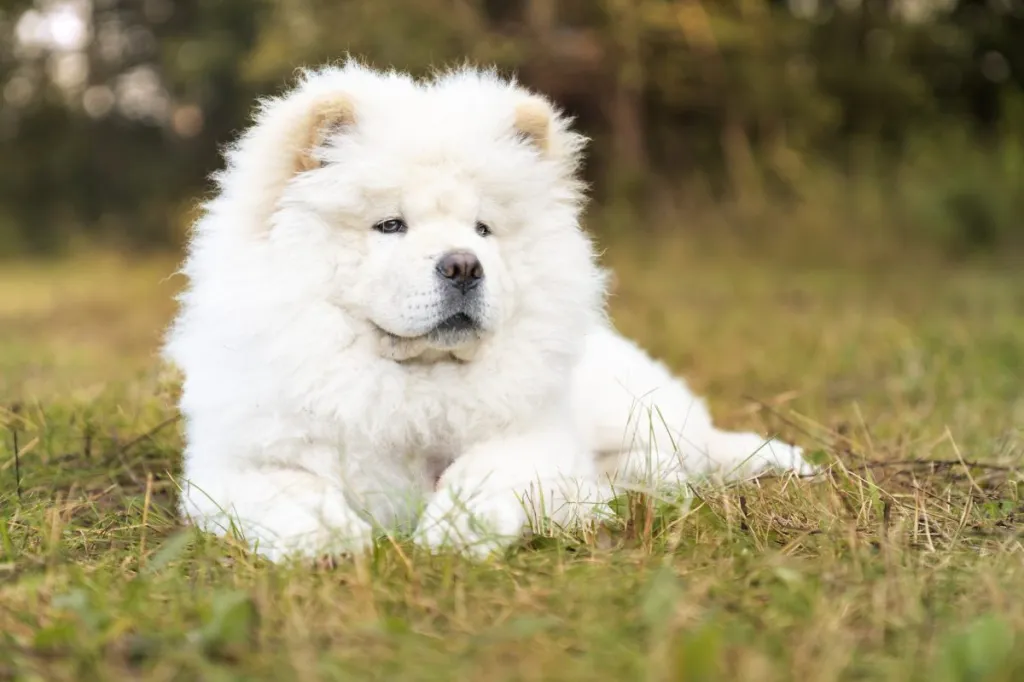
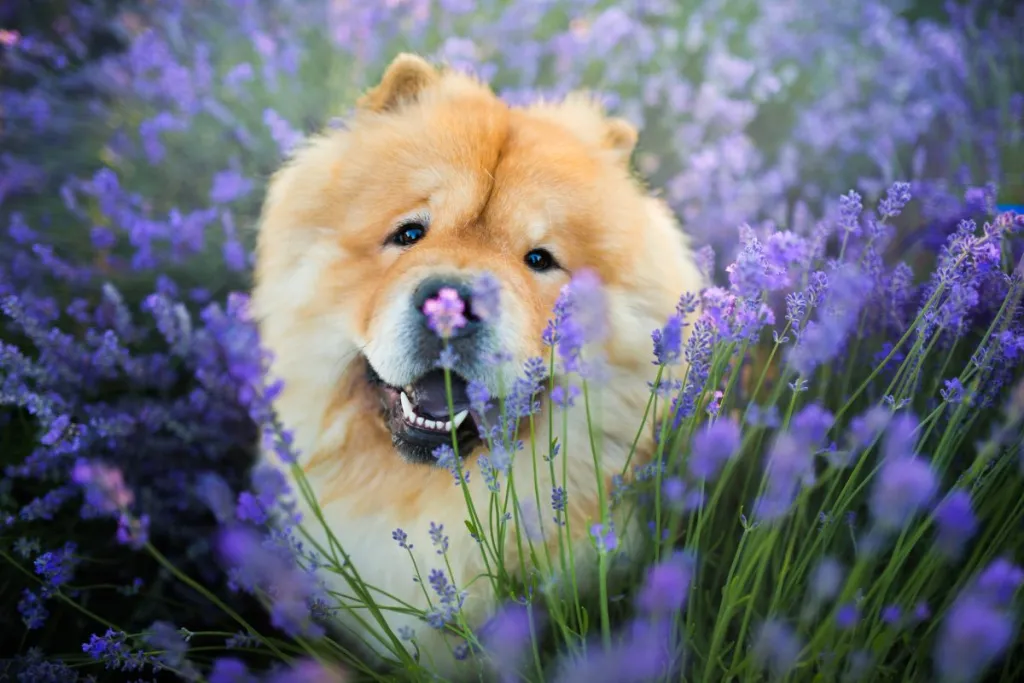
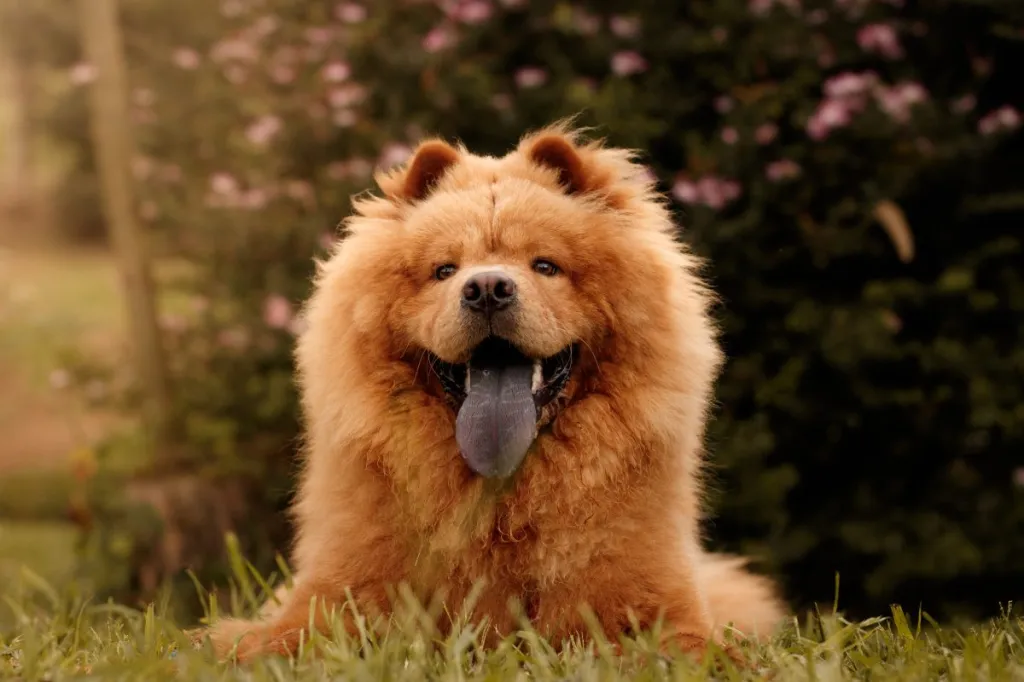
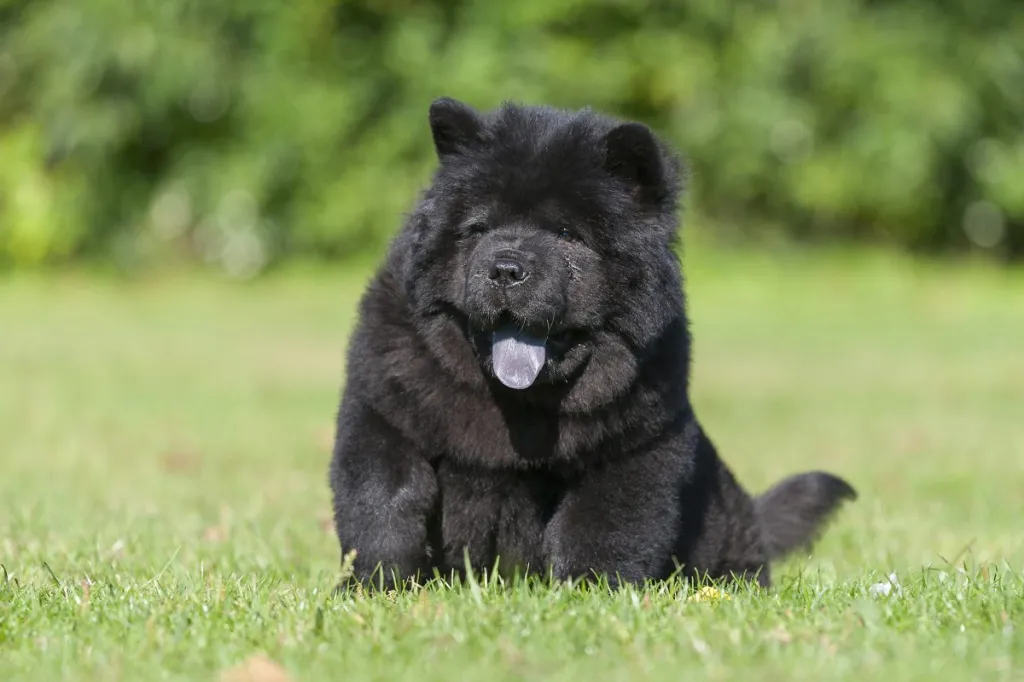
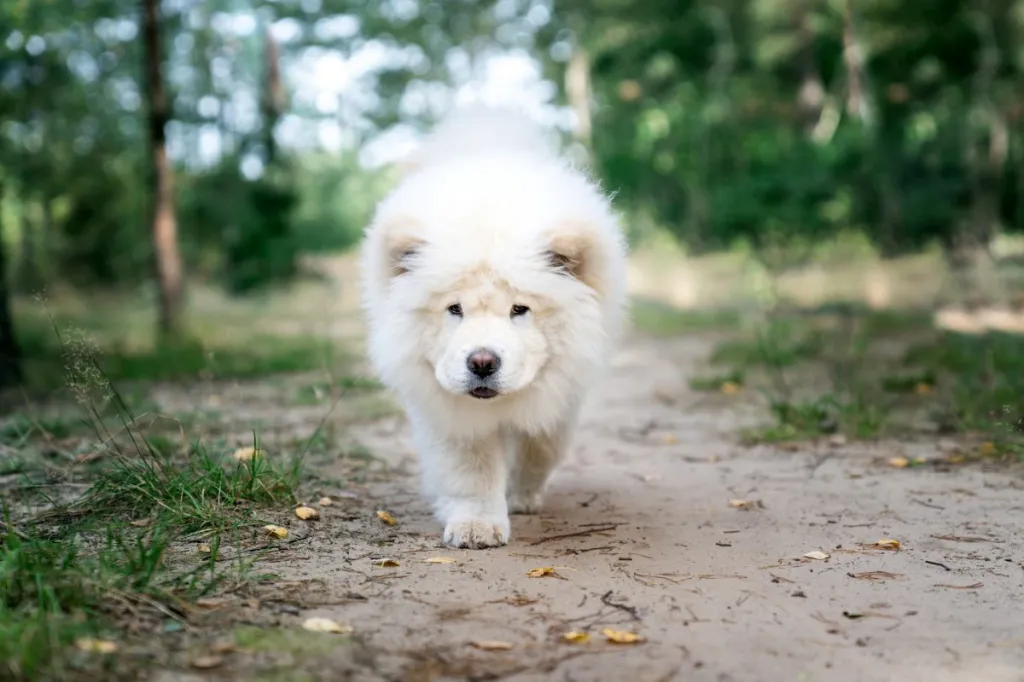
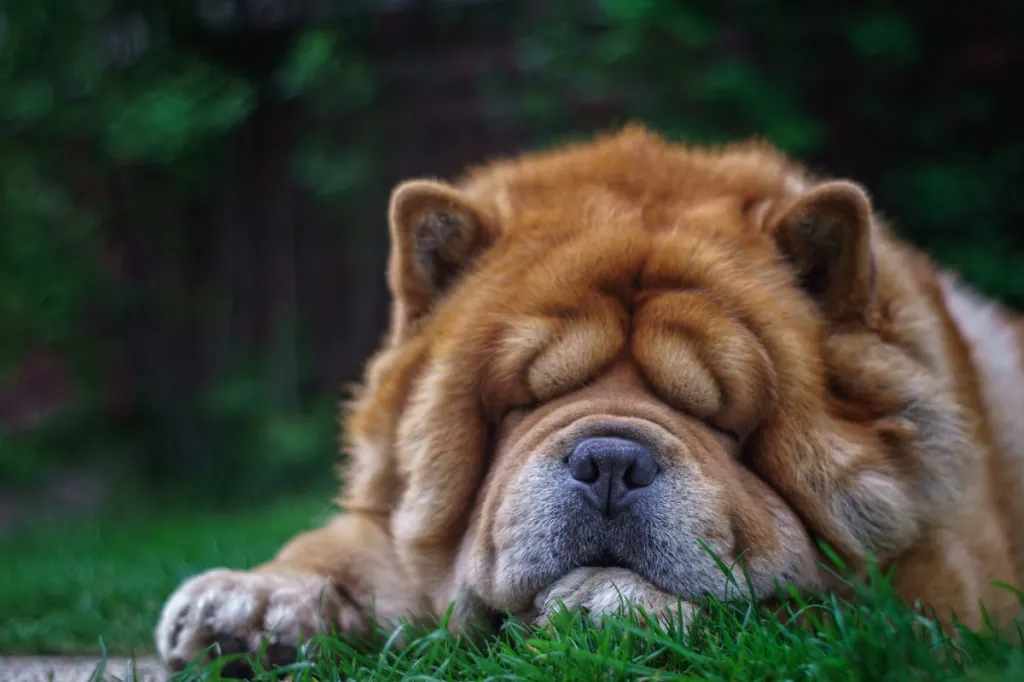
Adaptability
-
Adapts Well To Apartment Living
Looking for the best dog for your apartment? Contrary to popular belief, the suitability of dogs who adapt well to apartment living goes beyond its size. Apartment dwellers have a myriad of dog breeds to choose from as potential companions, with various factors to consider. Some large breeds can adapt well to apartment living and have lower activity levels. Others may require more space and possess higher energy levels. On the other hand, certain small dog breeds with abundant energy can still find contentment with indoor playtime or brisk walks.
However, when selecting a dog that adapts well apartments, it is essential to prioritize your neighbors. Opting for a pet that doesn’t excessively bark and behaves politely when encountering others in shared spaces like is crucial for maintaining a harmonious apartment environment.
In high-rise settings, it’s worth noting that numerous small dogs may exhibit a propensity for high energy and frequent barking. This makes them less suitable for apartment living. Therefore, desirable qualities in an apartment dog encompass being quiet, low-energy, and displaying polite behavior towards other residents.
Factors To Consider When Choosing A Dog For An Apartment
When considering dogs that adapt well to apartments, size alone should not be the sole determinant. Apartment dwellers have a wealth of dog breeds to choose from as potential furry companions. It’s important to remember that the size of your living space is just one factor to consider. While some larger breeds can adapt well to apartment living, with lower, others may require more space and have higher energy levels, making them less suitable for smaller apartments. Conversely, certain small dog breeds with higher energy levels can still thrive in apartments, finding contentment through indoor playtime or brisk walks. However, it is crucial to consider your neighbors’ comfort when selecting a dog. Opt for a pet that doesn’t bark excessively and behaves politely when interacting with others in shared spaces.
Therefore, it’s important to prioritize qualities such as being quiet, low-energy, calm indoors, and exhibiting good manners when living in close proximity to other residents. By considering these factors, you can find a dog that will adapt well to apartment living and create a harmonious living environment for everyone involved.
-
Good For Novice Owners
Some dogs are simply easier than others; they take to training better and are fairly easygoing. They’re also resilient enough to bounce back from your mistakes or inconsistencies.
Dogs who are highly sensitive, independent thinking, or assertive may be harder for a first-time dog parent to manage. You’ll get your best match if you take your dog-owning experience into account as you choose your new pooch.
If you’re new to dog parenting, take a look at 101 Dog Tricks and read up on how to train your dog!
-
Sensitivity Level
Some dogs will let a stern reprimand roll off their backs, while others take even a dirty look to heart. Low-sensitivity dogs, also called “easygoing,” “tolerant,” “resilient,” and even “thick-skinned,” can better handle a noisy, chaotic household, a louder or more assertive owner, and an inconsistent or variable routine. Do you have young kids, throw lots of dinner parties, play in a garage band, or lead a hectic life? Go with a low-sensitivity dog.
-
Tolerates Being Alone
Some breeds bond very closely with their family and are more prone to worry or even panic when left alone by their owner. An anxious dog can be very destructive–barking, whining, chewing, and otherwise causing mayhem. These breeds do best when a family member is home during the day or if you can take the dog to work.
-
Tolerates Cold Weather
Breeds with very short coats and little or no undercoat or body fat, such as Greyhounds, are vulnerable to the cold. Dogs with a low cold tolerance need to live inside in cool climates and should have a jacket or sweater for chilly walks. You can find a great jacket for your dog here!
-
Tolerates Hot Weather
Dogs with thick, double coats are more vulnerable to overheating. So are breeds with short noses, like Bulldogs or Pugs, since they can’t pant as well to cool themselves off. If you want a heat-sensitive breed, your dog will need to stay indoors with you on warm or humid days, and you’ll need to be extra cautious about exercising your dog in the heat.
All-around friendliness
-
Affectionate With Family
When it comes to unconditional love and unwavering loyalty, few animals can rival the affectionate nature of dogs. These remarkable creatures have earned their reputation as man’s best friend, and many breeds are particularly renowned for their love and devotion to their families. With their warm hearts and wagging tails, affectionate family dogs enrich the lives of their owners in countless ways.
One such breed known for its affectionate demeanor is the Golden Retriever. With their gentle temperament and friendly disposition, Golden Retrievers form deep bonds with their families. They eagerly participate in family activities, whether it’s a game of fetch in the yard or cuddling on the couch during a movie night. Their expressive eyes and ever-wagging tails are a testament to the joy they feel in the presence of their loved ones.
Another family-favorite breed is the Labrador Retriever. Renowned for their playful and patient nature, Labradors are excellent companions for children and adults alike. They readily engage in playtime with the kids, showcasing their boundless energy and enthusiasm. But when the day winds down, they seamlessly transition into loving and gentle cuddle buddies, comforting their family members with their warm presence.
Beyond specific breeds, mixed-breed dogs also have a special place in the hearts of families seeking affectionate companions. The shelter dogs, in particular, form deep connections with their adoptive families. They seem to understand the second chance they’ve been given and repay it with endless love and gratitude.
How To Know If A Dog Is Good With Families
The affectionate nature of family dogs extends beyond play and cuddles. Dogs have a remarkable ability to sense their owner’s emotions, offering comfort and support during difficult times. Whether it’s a wagging tail after a long day at work or a sympathetic nuzzle during moments of sadness, they prove time and again that they are attuned to their family’s needs.
It is important to note that not all dogs of the same breed will be equally affectionate. Some dogs may be more independent or aloof, while others may be more clingy or demanding of attention. The best way to find out how affectionate a dog is is to meet them in person and interact with them.
-
Kid-Friendly
Being gentle with children, sturdy enough to handle the heavy-handed pets and hugs they can dish out, and having a blasé attitude toward running, screaming children are all traits that make a kid-friendly dog. You may be surprised by who’s on that list: Fierce-looking Boxers are considered good with children, as are American Staffordshire Terriers (which are considered Pit Bulls). Small, delicate, and potentially snappy dogs such as Chihuahuas aren’t always so family-friendly.
**All dogs are individuals. Our ratings are generalizations, and they’re not a guarantee of how any breed or individual dog will behave. Dogs from any breed can be good with children based on their past experiences, training on how to get along with kids, and personality. No matter what the breed or breed type, all dogs have strong jaws, sharp pointy teeth, and may bite in stressful circumstances. Young children and dogs of any breed should always be supervised by an adult and never left alone together, period.
-
Dog Friendly
Friendliness toward dogs and friendliness toward humans are two completely different things. Some dogs may attack or try to dominate other dogs, even if they’re love-bugs with people; others would rather play than fight; and some will turn tail and run. Breed isn’t the only factor. Dogs who lived with their littermates and mother until at least six to eight weeks of age and who spent lots of time playing with other dogs during puppyhood, are more likely to have good canine social skills.
-
Friendly Toward Strangers
Stranger-friendly dogs will greet guests with wagging tails and nuzzles; others are shy, indifferent, or even aggressive. However, no matter what the breed, a dog who was socialized and exposed to lots of different types, ages, sizes, and shapes of people as a puppy will respond better to strangers as an adult. Remember that even friendly dogs should stay on a good, strong leash like this one in public!
Health And Grooming Needs
-
Amount Of Shedding
If you’re going to share your home with a dog, you’ll need to deal with some level of dog hair on your clothes and in your house. However, shedding does vary greatly among the breeds. Some dogs shed year-round, some “blow” seasonally, some do both, and some shed hardly at all. If you’re a neatnik, you’ll need to either pick a low-shedding breed or relax your standards. To help keep your home a little cleaner, you can find a great de-shedding tool here!
-
Drooling Potential
Drool-prone dogs may drape ropes of slobber on your arm and leave big, wet spots on your clothes when they come over to say hello. If you’ve got a laid-back attitude toward slobber, fine; but if you’re a neatnik, you may want to choose a dog who rates low in the drool department.
-
Easy To Groom
Some breeds are brush-and-go dogs; others require regular bathing, clipping, and other grooming just to stay clean and healthy. Consider whether you have the time and patience for a dog who needs a lot of grooming, or the money to pay someone else to do it.
-
General Health
Due to poor breeding practices, some breeds are prone to certain genetic health problems, such as hip dysplasia. This doesn’t mean that every dog of that breed will develop those diseases; it just means that they’re at an increased risk.
If you’re adopting a puppy, it’s a good idea to find out which genetic illnesses are common to the breed you’re interested in. You may also want to ask if your shelter or rescue has information about the physical health of your potential pup’s parents and other relatives.
-
Potential For Weight Gain
Some breeds have hearty appetites and tend to put on weight easily. As in humans, being overweight can cause health problems in dogs. If you pick a breed that’s prone to packing on pounds, you’ll need to limit treats, make sure they get enough exercise, and measure out their daily food servings into regular meals rather than leaving food out all the time.
Ask your vet about your dog’s diet and what they recommend for feeding your pooch to keep them at a healthy weight. Weight gain can lead to other health issues or worsen problems like arthritis.
-
Size
Get ready to meet the giants of the doggy world! Large dog breeds aren’t just big balls of fluff, they’re like loving, oversized teddy bears on a mission to steal your heart. Need some convincing? Let’s dive into the awesome benefits of owning one!
First things first, these pooches are a living security system! With their impressive size and thunderous barks, they’ll have any would-be intruder running for the hills. Talk about peace of mind! Plus, who needs an alarm when you’ve got a furry giant protecting your castle?
But that’s not all. Large dog breeds are all about loyalty and devotion. They’ll stick by your side through thick and thin, becoming your most dedicated bestie. Their love knows no bounds! When you have a giant fluffball showing you unconditional love, you’ll feel like the luckiest human on the planet.
Now, let’s talk about their talents. These big fellas are the ultimate working partners. With brains and brawn, they’re up for any challenge. From search and rescue missions to lending a helping paw to those in need, these dogs are superheroes in fur coats. They’ll make you proud every step of the way!
Don’t let their size fool you—these gentle giants have hearts as big as their paws. They’re incredible with kids and other pets, spreading their love like confetti. Their patience and kindness make them perfect family pets, ensuring harmony in your household.
Oh, and get ready to break a sweat! These dogs are fitness enthusiasts, and they’ll keep you on your toes. Daily walks, jogs, and play sessions will not only keep them happy and healthy but will also give you a reason to ditch the couch and join in on the fun. It’s a win-win situation!
So, if you’re ready for a dose of big love, go ahead and consider a large dog breed. They’re the best wing-dog you could ever ask for, ready to make your life a thousand times more exciting, loving, and downright awesome! Get ready for the big adventure of a lifetime!
Trainability
-
Easy To Train
Easy-to-train dogs are more adept at forming an association between a prompt (such as the word “sit”), an action (sitting), and a consequence (getting a treat) very quickly. Other dogs need more time, patience, and repetition during training.
Many breeds are intelligent but approach training with a “What’s in it for me?” attitude, in which case you’ll need to use rewards and games to teach them to want to comply with your requests.
Related:
10 Fun, Impressive Tricks You Can Teach Any Dog
-
Intelligence
Dogs who were bred for jobs that require decision making, intelligence, and concentration, such as herding livestock, need to exercise their brains, just as dogs who were bred to run all day need to exercise their bodies. If they don’t get the mental stimulation they need, they’ll make their own work–usually with projects you won’t like, such as digging and chewing. Obedience training and interactive dog toys are good ways to give a dog a brain workout, as are dog sports and careers, such as agility and search and rescue.
-
Potential For Mouthiness
Common in most breeds during puppyhood and in Retriever breeds at all ages, mouthiness means a tendency to nip, chew, and play-bite (a soft, fairly painless bite that doesn’t puncture the skin). Mouthy dogs are more likely to use their mouths to hold or “herd” their human family members, and they need training to learn that it’s fine to gnaw on chew toys, but not on people. Mouthy breeds tend to really enjoy a game of fetch, as well as a good chew on a toy that’s been stuffed with kibble and treats.
-
Prey Drive
Dogs with a high prey drive have an instinctive desire to stalk, capture, and prey upon potential food sources. Dogs who were bred to hunt, such as Terriers, have an inborn desire to chase — and sometimes kill — other animals. Anything whizzing by — such as cats, squirrels, and perhaps even cars — can trigger that instinct.
How to address a high prey drive
Off-leash adventures are too great a temptation for pups who will wander and hunt. Dogs who like to chase need to be leashed. And, even on a leash, you may experience your dog pulling on the leash to reach rodents or birds in their sight. Otherwise, these pups should be kept in a fenced area when outdoors. If your pup has a high prey drive, you’ll need a high, secure fence in your yard.
These breeds generally aren’t a good fit for homes with smaller pets that can look like prey, such as cats, hamsters, or small dogs. Breeds that were originally used for bird hunting, on the other hand, generally won’t chase, but you’ll probably have a hard time getting their attention when there are birds flying by.
Other behavioral concerns
Observing your dog’s prey drive, which is instinctual and biologically-rooted, is not the same as observing aggression. Much aggression is born of fear and anxiety, especially in the case of dog aggression toward humans.
The tendency to wander, even into oncoming traffic, can produce diasterious results for pups with predatory instincts. It can also lead to pups being bitten by snakes or attacked by other wild animals they may pursue while on the hunt.
-
Tendency To Bark Or Howl
Some breeds sound off more often than others. When choosing a breed, think about how often the dog vocalizes. Learn more about breeds with a tendency to bark or howl.
If you’re considering a hound, would you find their trademark howls musical or maddening? If you’re considering a watchdog, will a city full of suspicious “strangers” put your pup on permanent alert? Will the local wildlife literally drive your dog wild? Do you live in housing with noise restrictions? Do you have neighbors nearby? Then you may wish to choose a quieter dog.
-
Wanderlust Potential
Some breeds are more free-spirited than others. Nordic dogs such as Siberian Huskies were bred to range long distances, and given the chance, they’ll take off after anything that catches their interest. And many hounds simply must follow their noses–or that bunny that just ran across the path–even if it means leaving you behind.
Exercise needs
-
Energy Level
High-energy dogs are always ready and waiting for action. Originally bred to perform a canine job of some sort, such as retrieving game for hunters or herding livestock, they have the stamina to put in a full workday. They need a significant amount of exercise and mental stimulation, and they’re more likely to spend time jumping, playing, and investigating any new sights and smells.
Low-energy dogs are the canine equivalent of a couch potato, content to doze the day away. When picking a breed, consider your own activity level and lifestyle, and think about whether you’ll find a frisky, energetic dog invigorating or annoying.
-
Intensity
A vigorous dog may or may not have high energy, but everything they do, they do with vigor: they strain on the leash (until you train them not to), try to plow through obstacles, and even eats and drinks with great big gulps. These dynamos need lots of training to learn good manners, and may not be the best fit for a home with young kids or someone who’s elderly or frail. A low-vigor dog, on the other hand, has a more subdued approach to life.
-
Exercise Needs
Some breeds do fine with a slow evening stroll around the block. Others need daily, vigorous exercise, especially those that were originally bred for physically demanding jobs, like herding or hunting.
Without enough exercise, these breeds may put on weight and vent their pent-up energy in ways you don’t like, such as barking, chewing, and digging. Breeds that need a lot of exercise are good for outdoorsy, active people, or those interested in training their dog to compete in a high-energy dog sport, such as agility.
-
Potential For Playfulness
Some dogs are perpetual puppies — always begging for a game — while others are more serious and sedate. Although a playful pup sounds endearing, consider how many games of fetch or tag you want to play each day, and whether you have kids or other dogs who can stand in as playmates for the dog.
Chow Chow Overview
The Chow Chow, commonly known as Chow, possesses an impressive appearance with deep-set eyes and a large head, accentuated by a mane of hair. Although some might mistake his looks for being mean or ill-tempered, a well-bred and well-raised Chow is not aggressive. Instead, this breed is described as a combination of nobility like a lion, drollness like a panda, the charm of a teddy bear, the grace and independence of a cat, and the loyalty and devotion of a dog. As a breed that once graced imperial Chinese kennels, he carries an air of dignity and aloofness. While he may not be fond of excessive hugging or fussing, the Chow will be a quiet and attentive companion to his favorite person, extending his loyalty to other family members. He can get along with children if raised with them, but he’s best suited for homes with older kids who understand how to treat dogs with respect. Early positive encounters with strangers during puppyhood can help him remain calm around new people, but he remains highly territorial and protective, providing a clear warning to unwelcome intruders.
One of the most memorable physical features of the breed is its blue-black tongue, believed to have acquired its hue when a Chow licked up drops of the color during the creation of the world. The Chow’s almost straight rear legs give him a unique gait that may appear stiff or choppy. Although not a speedy dog, he has excellent endurance and can be a great walking companion. For training, verbal corrections usually suffice to guide the Chow Chow in the right direction. Physical punishment is counterproductive and won’t work with this proud and independent breed. Instead, firm consistency and earning his respect are key to successful training. If you appreciate the Chow Chow’s distinctive appearance and independent spirit, you’ll find a fiercely loyal companion who will be a true treasure in your household.
Chow Chow Highlights
- Appearance: Chow Chows are medium-sized dogs with a thick, fluffy coat that can be either rough or smooth. They have a distinctive lion-like appearance, with a large head, round eyes, and a pushed-up nose. Their coat can be a variety of colors, including red, black, blue, cinnamon, and cream.
- Temperament: Chow Chows are known for being independent, dignified, and loyal dogs. They are typically good with children, but they may not be as affectionate as some other breeds. They can be wary of strangers and need early socialization to be well-rounded dogs.
- Grooming: Chow Chows require a lot of grooming to keep their coat healthy and mat-free. They should be brushed at least once a week, and more often during the shedding season. They may also need to be bathed regularly, depending on their activity level.
- Health: Chow Chows are generally healthy dogs, but they are prone to some health problems, such as hip dysplasia, elbow dysplasia, and eye problems. They also have a higher risk of developing heatstroke than some other breeds.
- Lifespan: Chow Chows have a lifespan of 10-15 years.
Chow Chow History
Genetic testing has confirmed the long-held belief among experts that the Chow Chow is one of the oldest dog breeds in existence. This ancient breed is thought to have originated in Mongolia and Northern China, gradually migrating southward with the nomadic tribes. Depictions of dogs resembling the Chow Chow have been found in pottery and paintings dating back to the Han Dynasty (206 BC to 22 AD). One Chinese emperor was said to have kept an impressive 2,500 pairs of Chows as hunting dogs. Besides their hunting abilities, the dogs were prized as guardians of their owners’ possessions. Unfortunately, their fur was also used as trimming for coats, and their flesh was considered a delicacy.
In ancient China, the breed went by various names, such as the black-tongue dog (hei shi-tou), wolf dog (lang gou), bear dog (xiang gou), and Canton dog (Guangdong gou). The name “Chow Chow” emerged from British merchants in the late 18th century, who referred to various miscellaneous items, including dogs, as “chow chow.” The name eventually stuck to the breed. In 1781, the Chow Chow was described in a British book called “Natural History and Antiquities of Selbourne” by naturalist Gilbert White. Fanciers believe the breed has undergone little change since White’s observations more than 200 years ago.
Chow Chows began to be imported on a regular basis about a century later, with Queen Victoria showing a keen interest in the breed, further boosting its popularity. The breed club formed in England in 1895. In the United States, the first Chow Chow to appear at a dog show was Takya, who took third place in the Miscellaneous Class at the Westminster Kennel Club show in 1890. The American Kennel Club (AKC) officially recognized the breed in 1903, and the first Chow registered with the AKC was named Yen How.
During the 1920s, Chow Chows gained significant popularity among the rich and famous. They even found their way into the White House, where President Calvin Coolidge and his wife kept Timmy, a red Chow, and Blackberry, a black Chow. Notable figures like analyst Sigmund Freud and his daughter Anna also had a fondness for Chows, with Anna even breeding them.
More recently, Martha Stewart has been a fan of Chow Chows, and the breed has made appearances on her TV show. Currently, Chow Chows rank 64th in popularity among the 155 breeds and varieties recognized by the AKC.
Chow Chow Size
The Chow Chow’s height at the shoulder ranges from 17 to 20 inches, and they weigh between 40 to 70 pounds.
Chow Chow Personality
The Chow Chow’s temperament is often compared to that of a cat: aloof, reserved, independent, dignified, intelligent, and stubborn. Despite their scowling appearance, a well-bred Chow should never be aggressive or shy. Chows typically keep to themselves and avoid causing trouble. They enjoy playing with their family members, but strangers hold little interest for them unless they approach the Chow’s home without invitation — in which case, he will assertively challenge the trespasser. However, he will allow strangers to touch him if properly introduced by one of his owners. To ensure that a Chow Chow grows up to be a safe and relaxed adult, extensive socialization is crucial during puppyhood. This includes introducing them to new people, other dogs, and various situations.
Chow Chow Health
Just like all breeds, Chow Chows can be susceptible to particular health issues. The Canine Health Information Center suggests testing for the following:
Additionally, other common minor health concerns for Chow Chows include:
Chow Chow Care
Chow Chows are a versatile breed that can adapt to various living situations, whether it be a grand palace or a cozy apartment. However, they should always be kept indoors with their human companions rather than left outside in a backyard or kennel. Due to their intolerance to heat, it’s crucial to keep them indoors during sweltering weather to ensure their well-being. Like any dog, adult Chows require daily exercise to maintain their health and happiness. However, they don’t need excessive exercise and are content with a couple of 15-minute walks each day or one longer stroll.
Chow Chows tend to be homebodies and aren’t prone to wandering, but having a secure fence in the yard is still essential to protect them from traffic and prevent unwanted interactions with strangers in your absence. These dogs are easily housetrained, and crate training is highly recommended to facilitate the process and prevent any destructive behavior while you’re away. Remember that the crate should not be used as a form of punishment or confinement for extended periods; it is simply a useful tool for housetraining and safety.
Chows are highly intelligent and capable of learning various commands and tricks. A verbal correction is usually sufficient to guide them in the right direction. Physical abuse is never appropriate, especially with this proud and independent breed. Earning their respect through consistent and firm training during puppyhood will result in a well-behaved and obedient Chow. It’s crucial not to spoil the cute puppy and then try to train him later, as it may lead to behavioral issues. Establishing clear boundaries and training from an early age will create a harmonious and respectful relationship with your Chow Chow.
Chow Chow Feeding
The recommended daily amount of high-quality dog food for a Chow Chow is 2 to 2 3/4 cups, divided into two meals. The specific amount your adult dog needs will depend on factors such as size, age, build, metabolism, and activity level. Just like people, dogs are individuals and have different nutritional requirements. An active dog will naturally need more food compared to a less active one. The quality of dog food also matters; better-quality food provides more nourishment, and you’ll need to serve smaller portions.
To keep your Chow Chow in good shape, it’s essential to measure his food and feed him twice a day instead of leaving food out all the time. If you’re uncertain about his weight, you can perform an eye test and a hands-on test. When looking down at him, there should be a visible waistline. When you place your hands on his back with thumbs along the spine and fingers spread downward, you should be able to feel but not see his ribs without pressing too hard. If you can’t feel his ribs easily, it’s a sign that he may need less food and more exercise.
To learn more about feeding your Chow Chow, refer to our guidelines.
Chow Chow Coat Color And Grooming
Chow Chows come in two coat types: rough and smooth. The rough coat, commonly seen, is thick and abundant, standing off from the body like a parka. Underneath the outer coat lies a soft, thick, woolly undercoat. The hair around the head and neck forms a ruff or mane, and the tail is also thickly furred and lies over the back. On the other hand, the smooth-coated Chow Chow has a hard, dense, and smooth outer coat without any obvious ruff or feathering. Both coat types are available in five colors: red (ranging from light golden to deep mahogany), black, blue, cinnamon (light fawn to deep cinnamon), and cream. The colors may be solid or have lighter shadings in the ruff, tail, and feathering. When purchasing a puppy, be cautious of breeders charging extra for so-called rare or exotic colors like champagne, silver, lilac, chocolate, or white, as these are just fancy names for regular colors. Reputable breeders won’t charge premiums for them.
To maintain the coat in good condition and prevent loose hair from accumulating on clothes and furniture, regular brushing is necessary. Chow Chows are heavy seasonal shedders, so the coat requires extra attention during shedding periods. Regular brushing also helps prevent any doggie odor. Use a stainless steel Greyhound comb with medium-coarse teeth, a medium-size slicker brush for the legs, a medium pin brush for the longer body coat, and a spray bottle of diluted coat conditioner for misting the coat as you brush. Always brush a damp coat to avoid hair breakage and brush all the way down to the skin to prevent matting and tangles.
Grooming also includes dental hygiene and nail care. Brush your Chow’s teeth two or three times a week to remove tartar buildup and bacteria, with daily brushing being even better. Trim the nails once or twice a month, ensuring they don’t click on the floor, to keep the feet in good condition and prevent painful tears. It’s best to start grooming your Chow Chow when they are a puppy to get them accustomed to the process. Frequent handling of paws, mouth, and ears helps them get comfortable with grooming, making vet exams and other handling easier when they become adults. Make grooming a positive experience filled with praise and rewards to establish a good foundation for their grooming routine.
Chow Chow Children And Other Pets
Chow Chows can thrive in households with children if raised together, but they are not the rough and tumble type and may not tolerate excessive rough play or mistreatment from young children. For families with older children who understand proper dog handling, Chows can be wonderful companions. As with any dog, it’s essential to teach children how to approach and interact with the Chow and always supervise their interactions to prevent any potential incidents, such as biting or pulling of ears, from either the child or the dog.
When properly socialized and trained, Chows can get along well with other dogs and cats, especially if they are introduced to them during their puppyhood. However, Chows tend to get along better with dogs of the opposite sex and may be more prone to conflicts with dogs of the same sex. Ensuring proper socialization and training from a young age can significantly influence their behavior and compatibility with other pets.
Chow Chow Rescue Groups
Chow Chows are sometimes bought without any clear understanding of what goes into owning one, and these dogs often end up in the care of rescue groups, in need of adoption or fostering. Many rescues can be found using a quick internet search. You may want to start your search with the rescues listed below:
Chow Chow Breed Organizations
Finding a reputable dog breeder is one of the most important decisions you will make when bringing a new dog into your life. Reputable breeders are committed to breeding healthy, well-socialized puppies that will make great companions. They will screen their breeding stock for health problems, socialize their puppies from a young age, and provide you with lifetime support.
On the other hand, backyard breeders are more interested in making a profit than in producing healthy, well-adjusted dogs. They may not screen their breeding stock for health problems, and they may not socialize their puppies properly. As a result, puppies from backyard breeders are more likely to have health problems and behavioral issues.
